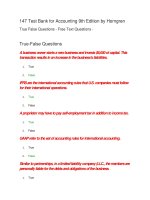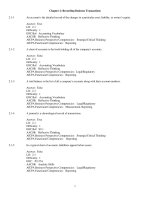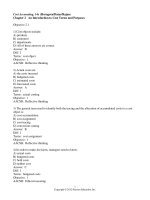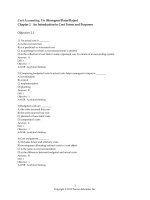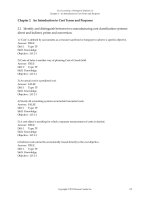horngren ima16 stppt15
Bạn đang xem bản rút gọn của tài liệu. Xem và tải ngay bản đầy đủ của tài liệu tại đây (680.64 KB, 59 trang )
Copyright © 2014 Pearson Education, Inc. publishing as Prentice Hall
15 - 1
Chapter 15
Basic Accounting:
Concepts, Techniques,
and Conventions
Copyright © 2014 Pearson Education, Inc. publishing as Prentice Hall
15 - 2
Chapter 15 Learning Objectives
1. Read and interpret basic financial statements.
2. Analyze typical business transactions using the
balance sheet equation.
3. Distinguish between the accrual basis of accounting
and the cash basis of accounting.
4. Make adjustments to the accounts under accrual
accounting.
5. Explain the nature of dividends and retained earnings.
6. Select relevant items from a set of data and assemble
them into a balance sheet and an income statement.
Copyright © 2014 Pearson Education, Inc. publishing as Prentice Hall
15 - 3
Chapter 15 Learning Objectives
7. Distinguish between the reporting of corporate owners’
equity and the reporting of owners’ equity for partnerships
and sole proprietorships.
8. Explain the role of auditors in financial reporting and
how accounting standards are set.
9. Identify how the measurement principles of recognition,
matching and cost recovery, and stable monetary unit
affect financial reporting.
10. Define continuity, relevance, faithful representation,
materiality, conservatism, and cost benefit (Appendix 15A).
11. Use T-accounts, debits, and credits to record
transactions (Appendix 15B).
Copyright © 2014 Pearson Education, Inc. publishing as Prentice Hall
15 - 4
The Need for Accounting
Accounting information can be used to assess past
financial performance of a company and help predict
its future performance. All kinds of organizations—
government agencies, nonprofit organizations, and
others —rely on accounting to gauge their progress.
The accounting process begins with a transaction.
A transaction is any event that affects the financial
position of an organization and requires recording.
Copyright © 2014 Pearson Education, Inc. publishing as Prentice Hall
15 - 5
The Need for Accounting
Many concepts, conventions, and rules
determine what events a company
records as accounting transactions and
how accountants measure the financial
impact of each transaction.
Financial statements are used to
summarize the recorded accounting
transactions.
Copyright © 2014 Pearson Education, Inc. publishing as Prentice Hall
15 - 6
The Need for Accounting
Managers, investors, and other internal groups
want the answers to two important questions:
How well did
the organization
perform?
Where does
the organization
stand?
Copyright © 2014 Pearson Education, Inc. publishing as Prentice Hall
15 - 7
Learning
Objective 1
The Need for Accounting
Accountants answer these questions
with three major financial statements:
Balance
sheet
Income
statement
Statement of
cash flows
Copyright © 2014 Pearson Education, Inc. publishing as Prentice Hall
15 - 8
Balance Sheet
The balance sheet (also called statement
of financial position or statement of financial
condition) is a snapshot of the financial status
of an organization at a point in time.
The balance sheet has two sections
(1) assets and
(2) liabilities plus owners’ (stockholders’) equity.
Copyright © 2014 Pearson Education, Inc. publishing as Prentice Hall
15 - 9
Balance Sheet
Assets are economic resources that
are expected to benefit future
activities of the organization.
Liabilities are the entity’s economic
obligations to nonowners.
Owners’ equity is the excess
of the assets over the liabilities.
Copyright © 2014 Pearson Education, Inc. publishing as Prentice Hall
15 - 10
Balance Sheet
The owners’ equity of a corporation
is called stockholders’ equity.
Stockholders’ equity
Copyright © 2014 Pearson Education, Inc. publishing as Prentice Hall
15 - 11
Learning
Objective 2
King Hardware Transactions
An Example
King Hardware Company began business as a
corporation—a business organized as a
separate legal entity and owned by its
stockholders. The company’s first transaction
occurred on February 28, 20X1, when its
stockholders invested a total of $100,000
cash.
Copyright © 2014 Pearson Education, Inc. publishing as Prentice Hall
15 - 12
King Hardware Transactions
The following additional transactions
occurred during March:
Copyright © 2014 Pearson Education, Inc. publishing as Prentice Hall
15 - 13
King Hardware Transactions
Analysis of Transactions (in dollars) for March
144,000
144,000
Copyright © 2014 Pearson Education, Inc. publishing as Prentice Hall
15 - 14
Balance Sheet
The balance sheet for King Hardware
Copyright © 2014 Pearson Education, Inc. publishing as Prentice Hall
15 - 15
Revenues and Expenses
Revenues are increases in ownership
claims arising from the delivery
of goods or services.
Recognize revenue by formally recording it in the
accounting records during the current period only after it
meets two tests:
1.The company must earn the revenues. That is, it must
deliver the goods or render the services to customers.
2.The revenue must be realized or realizable.
Copyright © 2014 Pearson Education, Inc. publishing as Prentice Hall
15 - 16
Revenues and Expenses
Expenses are decreases in ownership
claims (stockholders’ equity) arising from
delivering goods or services or using up assets.
Income (also called net income, profits, or
earnings), is the excess of revenues over
expenses. It increases stockholders’ equity.
An income statement summarizes revenues and
expenses. It measures an organization’s
performance by matching its revenue and its
expenses for a span of time, often a month, a
quarter, or a year.
Copyright © 2014 Pearson Education, Inc. publishing as Prentice Hall
15 - 17
Relationship Between Balance Sheet and
Income Statement
Copyright © 2014 Pearson Education, Inc. publishing as Prentice Hall
15 - 18
Income Statement
The income statement shows that General Mills’
stockholders’ equity (retained earnings) increased by
$1,804 million because of profitable operations in the
year ended May 29, 2011. This $1,804 million is
included in the $6,612 million of stockholders’ equity
on the May 29, 2011, balance sheet.
Copyright © 2014 Pearson Education, Inc. publishing as Prentice Hall
15 - 19
The Analytical Power of the
Balance Sheet Equation
The balance sheet equation can highlight the link
between the income statement and balance sheet.
Assets (A) = Liabilities (L) + Stockholders’ equity (SE)
A = L + Paid-in capital + Retained income
A = L + Paid-in capital + Revenue – Expenses
Copyright © 2014 Pearson Education, Inc. publishing as Prentice Hall
15 - 20
Learning
Objective 3
Accrual Basis and Cash Basis
The accrual basis of accounting
recognizes revenues and expenses
when they occur regardless of when
cash is received or disbursed.
The cash basis of accounting recognizes
revenue and expense when cash is
received and disbursed.
Copyright © 2014 Pearson Education, Inc. publishing as Prentice Hall
15 - 21
Accrual Basis and Cash Basis
The major deficiency of the cash basis
of accounting is that it is incomplete.
It fails to match efforts and accomplishments
in a manner that properly measures economic
performance and financial position.
Copyright © 2014 Pearson Education, Inc. publishing as Prentice Hall
15 - 22
Nonprofit Organizations
Nonprofit organizations, such as
government agencies and charitable
organizations, also use balance sheets
and income statements.
For years, most nonprofit organizations
used cash-basis rather than accrual accounting.
As these organizations face more pressure to
develop accurate measures of performance,
they are increasingly using accrual accounting.
Copyright © 2014 Pearson Education, Inc. publishing as Prentice Hall
15 - 23
Nonprofit Organizations
The basic concepts of assets, liabilities, revenues,
and expenses apply to all organizations, whatever
their goals and wherever they are located. However,
organizations that do not seek profits do not measure
income. Further, because they have no owners, there
is no owners’ equity.
Balance sheets of nonprofit organizations show a
category of “net assets” instead of “owners’ equity”
To measure the difference between assets and
liabilities. Instead of an income statement, nonprofit
organizations have a “statement of activities”
that reports changes in net assets.
Copyright © 2014 Pearson Education, Inc. publishing as Prentice Hall
15 - 24
Adjustments to the Accounts
Under the accrual basis of accounting, record:
1.Explicit transactions-day-to-day routine events
2.Implicit transactions - events that day-to-day
recording procedures temporarily ignore, such as
expiration of prepaid rent or accrual of interest
due to the passage of time.
Explicit transactions are easy to identify because
they are supported by source documents.
Implicit transactions are recorded at the end of
each accounting period by using adjusting entries.
Copyright © 2014 Pearson Education, Inc. publishing as Prentice Hall
15 - 25



